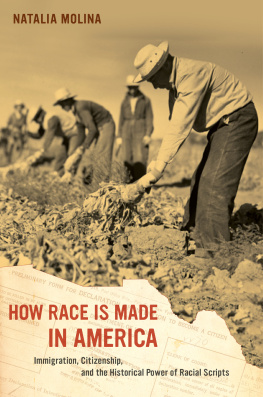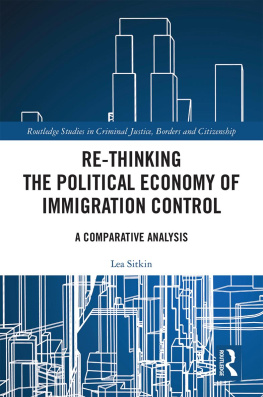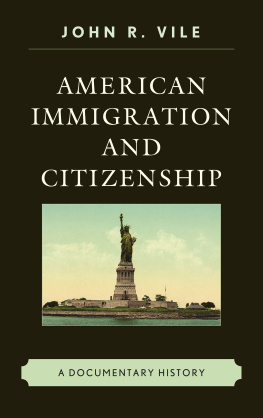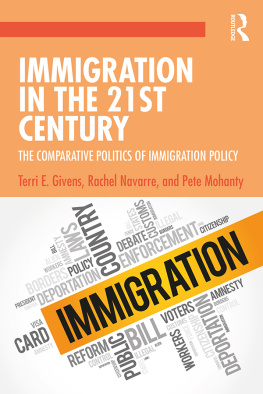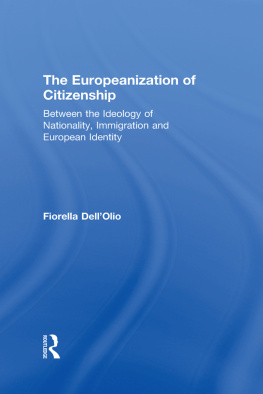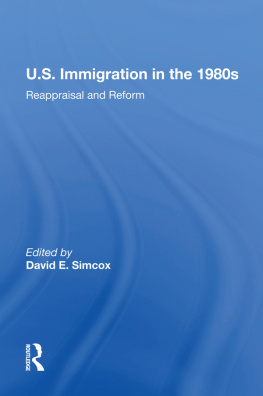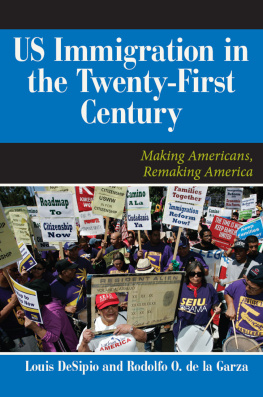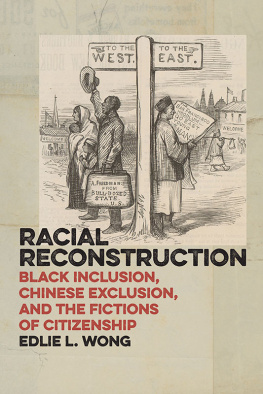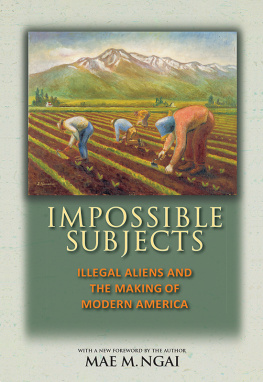
HOW RACE IS MADE IN AMERICA
AMERICAN CROSSROADS
Edited by Earl Lewis, George Lipsitz, George Snchez, Dana Takagi, Laura Briggs, and Nikhil Pal Singh
HOW RACE IS MADE
IN AMERICA
IMMIGRATION, CITIZENSHIP, AND THE
HISTORICAL POWER OF RACIAL SCRIPTS
Natalia Molina

UNIVERSITY OF CALIFORNIA PRESS
Berkeley Los Angeles London
University of California Press, one of the most distinguished university presses in the United States, enriches lives around the world by advancing scholarship in the humanities, social sciences, and natural sciences. Its activities are supported by the UC Press Foundation and by philanthropic contributions from individuals and institutions. For more information, visit www.ucpress.edu.
University of California Press
Berkeley and Los Angeles, California
University of California Press, Ltd.
London, England
2014 by The Regents of the University of California
An early version of Chapter 1 appeared as The Power of Racial Scripts: What the History of Mexican Immigration to the United States Teaches Us about Relational Notions of Race, Latino Studies 8, no. 2 (2010): 15675.
An early version of chapter 2 appeared as In a Race All Their Own: The Quest to Make Mexicans Ineligible for U.S. Citizenship, Pacific Historical Review , May 2010, 167201.
An early version of chapter 4 appeared as Constructing Mexicans as Deportable Immigrants: Race, Disease, and the Meaning of Public Charge, Identities: Global Studies in Culture and Power 17, no. 6 (2010): 64166.
Library of Congress Cataloging-in-Publication Data
Molina, Natalia.
How race is made in America : immigration, citizenship, and the historical power of racial scripts / Natalia Molina.
pages cm
Includes bibliographical references and index.
ISBN 978-0-520-28007-6 (cloth : acid-free paper)ISBN 978-0-520-28008-3 (paper acid-free paper)
eISBN 9780520957190
1. Mexican AmericansSocial conditions20th century. 2. Mexican AmericansCivil rightsHistory20th century. 3. ImmigrantsUnited StatesHistory20th century. 4. CitizenshipUnited StatesHistory20th century. 5. Race discriminationUnited StatesHistory20th century. 6. United StatesEmigration and immigrationHistory20th century. 7. United StatesEmigration and immigrationGovernment policyHistory20th century. 8. DeportationUnited StatesHistory20th century. 9. United StatesRace relationsHistory20th century. I. Title.
E184.M5M587 2013
305.868'72073dc23
2013018468
Manufactured in the United States of America
23 22 21 20 19 18 17 16 15 14
10 9 8 7 6 5 4 3 2 1
In keeping with a commitment to support environmentally responsible and sustainable printing practices, UC Press has printed this book on Rolland Enviro 100, a 100% post-consumer fiber paper that is FSC certified, deinked, processed chlorine-free, and manufactured with renewable biogas energy. It is acid-free and EcoLogo certified.
For Ian
CONTENTS
LIST OF ILLUSTRATIONS
ACKNOWLEDGMENTS
George Lipsitz once told me that scholarship is done in solitude but not in isolation. I have found this observation to be as insightful as it is concise. In preparing these acknowledgments, I felt both overwhelmed and humbled recalling how many people generously shared their time and expertise with me.
First, I want to thank American Crossroads series editors George Lipsitz and George Snchez for their tremendous support. As when I worked with them on my first book, I am very grateful for their ability to suggest new ways for me to think about various aspects of my work. They drew my attention to deeper possibilities in sections of text that I had thought were ready for publication, showing me where more layers could be exposed and additional interpretations teased out. George Lipsitz helped at two critical stages: the first occurred when, after taking the first draft as far as I could, I asked for his help. He provided substantive feedback (and a long reading list) that strengthened the manuscript. After I completed another round of revisions, he read the manuscript again, and I also shared my new draft with George Snchez. They jointly suggested further revisions in key sections. This book is all the better for their insight, suggestions, and support.
I also acknowledge with gratitude the many invitations I received to present parts of the in-progress manuscript, including those from the Newberry Library Seminar in Borderlands and Latino Studies; the Center for the Study of Race, Politics, and Culture at the University of Chicago; the Department of Languages and Literatures, University of Bologna; the Department of Ethnic Studies at the University of Colorado, Denver; the Department of Chicano-Latino Studies at the University of California, Irvine; the Latino/a Studies Program at the University of Michigan, Ann Arbor; the 2010 University of California International Migration Conference, hosted by UC San Diego; the American Studies Department at the University of Notre Dame; Universit Paris Diderot; the Latino Studies Department at Williams College; the Center for Race and Ethnicity at Rutgers; and the conference Transnationalism and International Migration in Historical Perspective at the University of California, Los Angeles. Through these presentations, I was able to test ideas, field thought-provoking questions, and receive valuable feedbackall of which helped me move past pressure points in the manuscript and see the work from different perspectives. I also appreciate the responses I received at scholarly conferences, including those sponsored by the Organization of American Historians, the Western Historical Association, and the Pacific Coast Branch of the American Historical Association.
As grateful as I am for the valuable feedback provided at formal talks, I would have had nothing to present had it not been for the help of my generous friends and colleagues who listened, brainstormed, encouraged, and commented on the kind of early draft that is shared only with trusted individuals. In Bird by Bird , writer Anne Lamott recalls E. L. Doctorows observation, Writing a novel is like driving a car at night. You can see only as far as your headlights, but you can make the whole trip that way. Conversations with friends and colleagues via email, at conferences and invited talks, and over shared meals and coffee served to light my way. Thank you to Meg Wesling, Nancy Postero, Pablo Mitchell, Jose Alamillo, Laura Briggs, Scott Kurashige, David Serlin, Angela Garcia, John McKiernan-Gonzalez, Alex Stern, Gerry Cadava, John Alba Cutler, Anne Fabian, Mia Bay, Roger Waldinger, Nancy Green, Jason Ruiz, Mrida Ra, Ondine Chavoya, Ana Rosas, and Faye Caronan. I would especially like to thank Ernesto Chvez, who, during an informal conversation at a conference, suggested the term racial scripts to name what I was describing. I am indebted as well to Vicki Ruiz, Miroslava Chvez-Garcia, and Kelly Lytle-Hernandez. They are not only remarkable historians but are also noble colleagues who share their knowledge without hesitation and with deep generosity. Last, I would like to thank the members of the best running group, In Motion Fit. At times I thought of calling this book What I Talk about When I Run to acknowledge how often I shared my ideas and progress with my Saturday morning runningbuddies. Those conversations forced me to make my arguments clear and compelling to a nonacademic audience.
Next page
